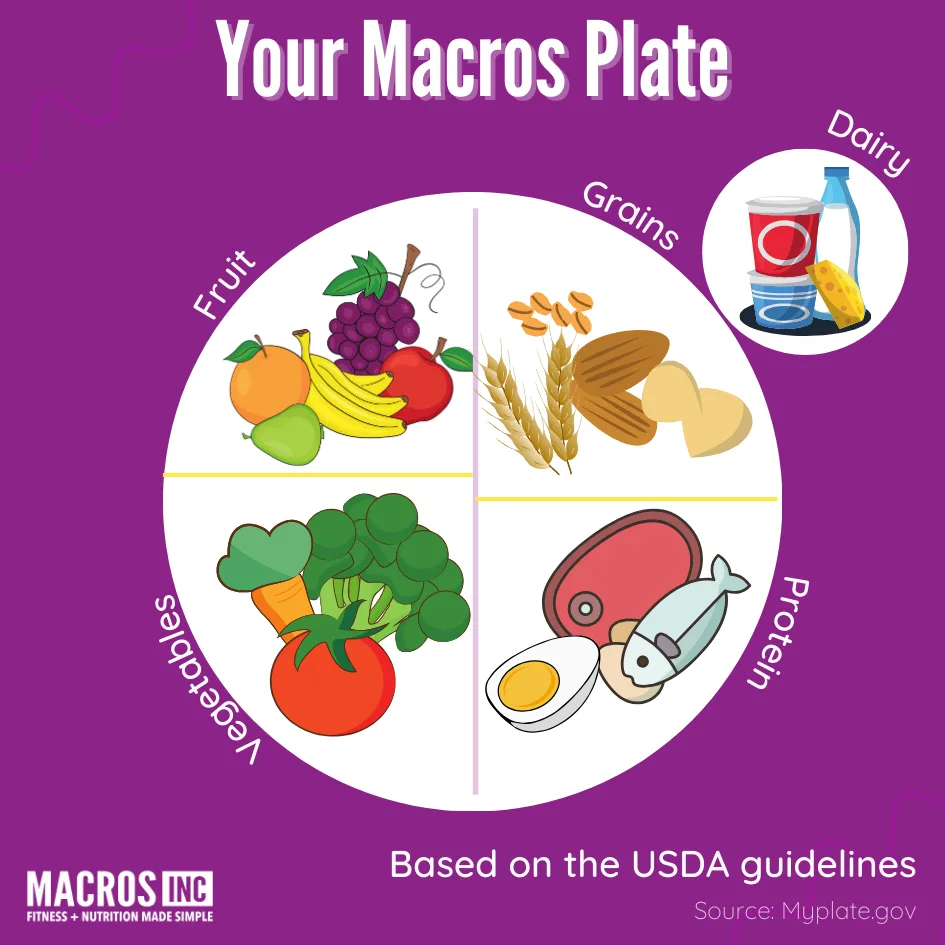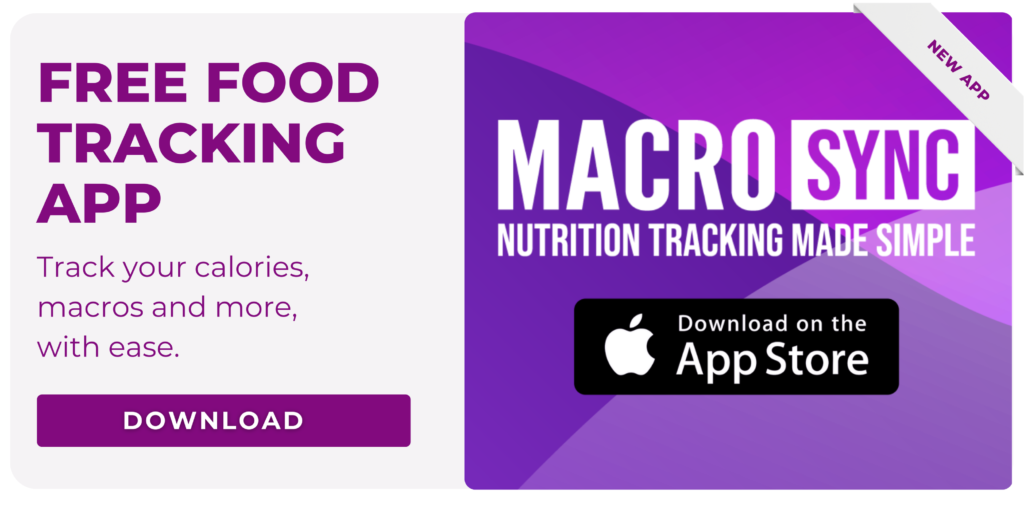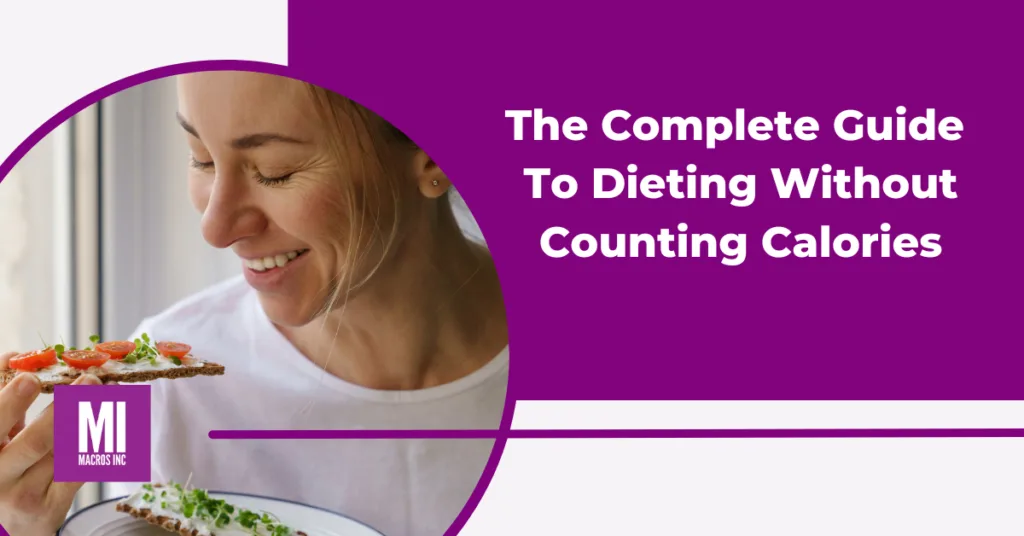Diets come in many shapes and sizes. Although one of the most effective routes is through calorie and macro counting, it isn’t always the most feasible approach. Whether it’s due to difficulties tracking or an aversion to number crunching, calorie and macro counting may not be for you.
However, it is still entirely possible to diet effectively without tracking a single calorie. This guide is a walkthrough to dieting without counting calories, including the strategies and considerations for doing so. By the end, you should be well on your way to planning out your ideal approach moving forward.
So, let’s get started by talking about fat loss itself.
Jump to a Topic
The Complete Guide to Dieting Without Counting Calories
How Does Fat Loss Work?
In short, it’s all about energy. The unit we use to measure this energy is called a Calorie.
All food that you eat has an inherent number of calories. When you digest said food, that energy is released into your body. The energy is then used to fuel all of the basic functions your body needs – upkeep, movement, organ function, building new tissues, etc.
Once that is finished, things can take a couple different routes, depending on how much energy you take in vs. how much your body needs. These totals also dictate what happens to the fat stores in your body. Here, we’re simplifying by assuming all weight change is due to fat loss and gain. This isn’t necessarily the case, but for most intents and purposes, the majority of weight lost or gained with time come from bodyfat changes (Figure 1).
| Energy Intake | Caloric State | Impact on Body Mass |
| Exceeds body’s needs | Caloric Surplus | Fat Gain |
| Meets body’s needs | Caloric Maintenance | Fat Maintenance |
| Less than body needs | Caloric Deficit | Fat Loss |
For simple purposes, you can think of your body as an energy bank, with calories as currency. You have a certain amount that is always spent for things like bills. That’s akin to the needs your body has for its daily processes. Past that, you deposit any extra money you need, and withdraw money when needed. These are analogous to gaining and losing bodyfat, respectively.
Fundamentally, this is always how fat loss and gain works. In other words, a diet must create a calorie deficit. So why is it that there are so many non-counting diets that still elicit progress?
Why Do Different Diets All Work?
There are a seemingly endless number of diets out there, each with the common goal of fat loss. Results vary widely from person to person, but there’s no doubt that there are many successful strategies towards dieting. As diverse as they are, they all have the same universal trait as discussed above. They all create a calorie deficit.
Thing is, the body will sense its caloric intake, regardless of whether you’re counting calories or not. As long as the approach causes you to stay in a net calorie deficit, fat loss will happen. There are many ways to “trick” someone into creating that deficit, but the end results are generally similar (Table 2).
As long as a caloric deficit is included in a dietary approach, the method should elicit some degree of fat loss. However, this comes with an additional caveat: The diet has to be something that can be stuck to for an extended period of time. Significant fat loss doesn’t happen overnight, so sustainability is a large part of a diet’s effectiveness.
Building off of that, food choice also plays a big role in sustainability. While the only hard and fast rule is a calorie deficit, how that deficit is achieved is a notable factor. While two foods may have the same energy value in calories, the macronutrients, amount of food, and satiation you get between the two can differ greatly (Table 3). This also doesn’t take into account the large potential differences in nutritional value (i.e. micronutrients) between the two.
| Food | Amount per 1000 Calories | Macronutrient Composition (Protein, Fat, Carbohydrate) |
| Chicken Breast | 606g (21.4 oz) | 188g P, 22g F, 0g C |
| Glazed Donut | 257g (5 donuts) | 16g P, 58g F, 116g C |
| Peanut Butter | 170g (10.5 tbsp) | 43g P, 85g F, 32g C |
| Non-Fat Greek Yogurt | 1695g (59.8 oz) | 173g P, 6.6g F, 61g C |
In summary, a diet does not need to involve counting calories or macros to succeed. It does, however, need the following two key points:
- The diet must create a calorie deficit.
- The diet must be sustainable for an extended period of time.
Now that we have the basics, let’s jump into how to set up a diet without counting.
Strategies For Dieting Without Counting Calories
Aside from the above requirements, the approach itself can be very open ended and customized to individual needs and preferences. When constructing a diet without counting calories, there are many different methods and tricks you can implement. Here is a list of some approaches and factors that may make your efforts easier:
Plate Method
The plate method is a visual way to proportion the different foods for a given meal. There are a few different distributions from different sources, but they all follow a similar pattern:
- 1/4 of the plate is for grains and starches
- 1/4 of the plate is for protein-rich foods
- 1/2 of the plate is for greens
- Half of the greens are crunchy, leafy, vegetables
- The other half are reserved for fruits
- Dairy is often highlighted as a valuable addition

Portion Control
This approach focuses less on the composition of your meals, and more on the quantity. If you take a given meal, and simply reduce the amount prepared or consumed, this proportionally reduces the calories as well. For example, if you normally have a couple slices of toast in the morning, cut it back to one. If you usually have a couple scoops of ice cream as dessert, reduce the scoops from 2-3 down to 1-2.
It is worth noting that this approach tends to shine particularly well when combined with one or more of the other approaches listed here. It is much easier to remain satiated if you cut back on an already balanced meal.
Reducing/Dropping Difficult Foods
This involves some extra consideration to your choice in foods and snacks throughout the day. Every food has both a caloric and a satiety value, i.e. certain foods are more filling and less calorie dense than others. The easiest foods to minimize or eliminate are those that do little for fullness, and/or are heavily packed with calories. There are a few typical culprits to consider here:
- Liquid calories (soda, fruit juice, etc.)
- Things that can be snacked on mindlessly (chips, cookies, crackers, candy, etc.)
- Spreads (butter, nut butters, jams/jellies, etc.)
- Dressings/oils (Salad dressings, cooking oils, etc.)
Depending on preferences, it may be potentially easier to reduce some of these sources vs. eliminating them entirely. The main goal is to get you thinking about these, not agonizing over whether you should eat them or not.
Altered Eating Patterns
This factor is simple in concept: place your meals around where they will benefit you most. The considerations here include the times of day you tend to be hungriest, around exercise or training, or when cravings are most likely to hit. One popular adaptation of this concept is intermittent fasting. This approach limits your intake to certain hours of the day, and restricts it during the rest of it.
With these patterns, they are heavily contingent on your personal needs and preferences. For example, if you like to snack constantly throughout the day, restricting your intake to 2-3 large meals a day may cause problems with hunger and/or energy levels. Conversely, If you like having your meals as larger, dedicated sittings, spreading your calories across several smaller meals may be unfulfilling.
Other Considerations
These aren’t necessarily methods in of themselves for a diet. However, they tend to have a significant impact on overall success, and are worth mentioning.
Supplements and Meal Replacements
Both supplements and meal replacements tend to be similar, but have slightly different intended purposes. Supplements are extremely diverse, with a wide variety of different shapes, compositions, and intended uses. Meal replacements are a kind of dietary supplement consisting of things such as special shakes, bars, and powders that are intended to replace an actual full meal.
While supplementation needs are dependent on the individual and their diet, the most important thing to remember is that supplements are supposed to be just that – something to supplement one’s diet, i.e. they augment the main diet with things that may help meet one’s needs. From a nutritional and satiety standpoint, it is usually a poor idea to replace food with supplements as the sole source of nutrients, let alone entire meals.
Eating Out
In today’s day and age, it’s extremely difficult to abstain from eating out entirely. From social events to the occasional meal ordered in, eating out is a part of our lives, at least to some degree. From a diet standpoint, this is not necessarily all doom and gloom. Many of the strategies described above can still be applied to a meal out. However, there are a couple different considerations to keep in mind.
First up are calorie listings. It has become more and more common for eateries to list the nutritional facts of their foods for their diners. While this is overall a benefit, it is important to take these values with a grain of salt. All of these listed numbers are estimates, taken from an average compiled by the establishment itself. The actual caloric value of a meal can vary widely depending on its preparation. If a chef gets heavy handed with the cooking oil, or the cook tosses a few extra fries into the bag, that can substantially bump the totals higher. As a general rule, you can expect the listed calories to actually be 20% higher, or more.
Next, most places will have a variety of different dishes to choose from. While you may not know the exact calories of the different entrees, you can make some informed decisions about which choices align better with your goals, and which ones are more likely to throw things off. Here are some of the things to watch for:
- Battered and/or deep fried foods
- Dishes heavy in sauces and/or oils
- Bottomless sides, e.g. tortilla chips, complementary bread, etc.
All in all, remember that the whole goal is balance. You shouldn’t have to become a social hermit to make progress, but it would be wise to limit extraneous outings if possible.
Body Composition
This ties something that most dieters experience at some point or another in their efforts. Progress comes along nicely at first. You see the scale going down, clothes start to fit better, and all the other good stuff. After a while though, progress starts to come to a crawl, or stalls entirely. While it’s certainly possible something has slipped through the cracks, it very well may be that you’ve been doing everything right. So what gives?
The unfortunate truth is that the leaner you get, the more difficult things get. It takes increasingly more effort to lose increasingly smaller amounts of bodyfat, in a rough double whammy. This can vary widely depending on the individual person and their goals. For someone starting out, simply cutting out soda may be enough to kick start their progress. On the other extreme end of the spectrum, a competitive bodybuilder will have to track virtually every calorie they eat in order to get to a competition level physique.
So, if your progress starts to peter out, you may need to get stricter with your methods, cut more things out, etc. Ultimately, where your dietary journey ends is entirely your call. You get to decide at what point the effort is no longer worth the increase in progress, and that’s perfectly okay – your goals aren’t reflective of another’s, and vice versa.
Coaching
With coaching, the goal is to have a dedicated expert to help you with various aspects of your dietary journey. Coaches provide help in a variety of different ways, usually dependent on the dieter themselves and what they need most.
One example lies with information. The inundation of different online sources can be overwhelming. You can test this simply by searching something as simple as “how to lose weight.” You’ll get literally dozens of different answers and reasons, many seemingly contradicting the others. A coach can assist with parsing out the more solid information, especially from a scientific standpoint.
Another factor is personalization. It may very well be that you know all of the things necessary to make progress. However, actually applying those things to your life may be much easier said than done. You may work a challenging job, or have a family that you need to feed and support. A coach can help you figure out a suitable balance, helping you to both make dietary progress while still addressing your life needs.
Finally, you have accountability. While you may know exactly what you need to do and how to do it, it can often be easier said than done to actually stick to the plan. With a coach, you’re held accountable to another person. This can make a huge difference in terms of dietary adherence. On the other end of the spectrum, some people tend to be really hard on themselves regarding dietary missteps or shortcomings. Having an objective outsider can make self-evaluation much more fruitful.
Coaching is almost always a viable option, and you may wish to ask yourself if coaching may be right for you. If you’re on the fence, you can always give it a try for free, and see how it feels.

Wrap Up
When the fundamentals are met, the sky is theoretically the limit in constructing a successful diet. Now that you have the basic principles and some of the methods, you are well on your way toward kicking off your journey. And as always, if you ever need further assistance, don’t be afraid to reach out. We’re always happy to help!
Try our nutrition coaching, for free!
Be the next success story. Over 30,000 have trusted Macros Inc to transform their health.
Simply fill out the form below to start your 14-day risk-free journey. Let's achieve your goals together!

